 Sorry, no. There are some breeders who claim that Bengals “may” be “less likely” to trigger symptoms of cat allergies than other cats, but sadly this isn’t really true.
Sorry, no. There are some breeders who claim that Bengals “may” be “less likely” to trigger symptoms of cat allergies than other cats, but sadly this isn’t really true.
There is a misconception that it is a cat’s fur that people are allergic to, but in fact people with cat allergies are really allergic to proteins in the cat’s saliva, urine and secretions from a cat’s sebaceous glands known as Fel d1, and dander (dried flakes of skin). The fur itself is not the culprit, but it is a carrier of the allergens.
This may be behind the myth that Bengals are hypoallergenic; Bengals shed less hair than some other breeds because they have a single, short coat. They do still shed hair though, and while cat hair is a carrier of cat allergens, it is not the real culprit. Cat allergens are microscopic particles that when dry flake off and float freely throughout the air before they settle on everything in your home. Fel d1 also has a sticky quality, clinging to any surface it comes in contact with.
The severity of cat allergies can vary from person to person. But generally if someone is allergic to a cat they often have allergic reactions to other substances such as pollen, dust mites, perfume, makeup, mildews or molds etc. Further, allergies are cumulative; people have a tolerance level and when the total exposure to allergens goes above this threshold the allergy occurs. So it is important to not only minimize exposure to cat allergens, but also to other allergens that trigger an attack.
If you are set on a Bengal despite having allergies, there are some things you can do to help keep the allergens in your home to a minimum and help reduce allergic reactions:
1) Male cats generally produce more Fel d1 than females, so males are more likely to trigger reactions. Female Bengals still produce allergens however so keep that in mind when selecting your cat. If possible visit the breeder and spend some time around the cats so you can assess the severity of your reaction. Make sure to spend time around the adult cats, as kittens have less skin to shed and therefore diminished dander so don’t be lulled into a false sense of security if you are okay around the kittens only.
2) Wash your hands immediately after handling your cat, and try not to touch your face (especially your eyes or nose) until you have done so. Avoid hugging or kissing it, which may be obvious for adults but for children it may not be as easy.
3) Keep the cat out of the bedroom at all times. Keep the door closed and make it completely out-of bounds for kitty. Even if your cat stays out of your bedroom allergens can still make their way in, so consider using impermeable covers for the mattress and pillows.
4) Don’t handle the kitty litter if possible; it’s a great excuse to make this someone else’s job, or better yet toilet train your Bengal and get rid of litter forever! If you are living with litter make sure it is cleaned regularly to prevent build up of the proteins from the urine. Avoid clay litter that can generate dust and aggravate allergies, and use a clumping litter. If the allergy sufferer must do litter duty, they should wear a mask to cover their nose and mouth to avoid inhaling the allergens.
5) Clean regularly – The more often you can vacuum the better, daily if necessary. Invest in a vacuum with a HEPA (high-efficiency particulate air) filter that is fine enough to catch allergens, as normal vacuums may blow the allergens into the air and actually make things worse. Vacuum not only the floor but the furniture too. Consider using cleaning products especially formulated to neutralize cat dander and other allergens. Dust with a damp cloth and mop the floors regularly. As cleaning can cause particles to circulate in the air, the allergy sufferer should wear a mask to cover their nose and mouth to avoid inhaling the allergens while cleaning.
6) Use washable throw rugs over your couches and wash them weekly.
7) Get rid of carpet in your home as it will harbor the dander cats produce. Opt for floorboards or tiles instead. The same with material curtains or blinds; opt for non-material window dressings.
8) Central air conditioning and heating recirculates the same air throughout the home along with the microscopic allergen particles, so it can help to use very fine wafer thin filtration material over the ducts of forced air systems, particularly at point of entry to your bedroom. Use fabric that is not too thick so as not to stop the airflow all together. Have your duct work professionally cleaned every three years.
9) Open several windows in your home to encourage natural circulation of air whenever possible. Beware if the allergy sufferer is also sensitive to pollen and if so avoid doing this during high-pollen periods.
10) Invest in an electrostatic or HEPA air cleaner, which picks up small airborne particles. Make sure to have one in the bedroom, but you may want to use them in other rooms in the house as well. Some good air-cleaners and other products for allergy sufferers can be found here: http://www.allergybuyersclub.com/
11) Bathe your Bengal. A weekly bath to wash away the allergens can help reduce them in your home, but the reduction will not last longer than a week so if you can’t stick to a weekly bathing schedule you’re wasting your time.
Make sure you use a shampoo formulated and pH balanced for cats. Human shampoos are the incorrect pH for a cat’s skin and hair and can result in skin irritation and flaking, which is not only uncomfortable for your cat but it can make the allergen situation even worse. You also need to ensure to rinse your Bengal thoroughly to remove all residue of the shampoo from their coat.
Bengals can have more of an affinity to water than other breeds, but this is not a guarantee (my girls are fascinated with running taps but don’t like to immerse themselves in water). But cats can learn to tolerate baths, particularly when they are accustomed to them as a kitten.
An alternative to bathing is to wipe your cat down with anti-allergen pet wipes or use a an anti-allergen product such as Allerpet/C once or twice a week http://www.demite.com/allerpet/cats-allerpetc/
12) Comb/Brush your Bengal once or twice a week between baths, as this can also help remove dander, saliva and secretions from their coat. It can also help to keep your Bengal’s skin and hair in good condition. Try to do this outside to prevent allergens entering the atmosphere of your home. If possible, a non-allergic family member should groom or clean the cat, but if this is not possible wear a protective mask when grooming. Wash your clothing immediately afterwards as it can collect allergens during the process.
13) In addition to bathing your Bengal, it is important to regularly wash their bedding to reduce the build up of dander, dried saliva and secretions.
14) Minimize your exposure to ALL allergens. Remove plans in your garden that produce allergy-causing pollens, try to eliminate damp areas in your home that can promote the growth of mold, wash your bedding regularly to reduce dust-mites. Remember, if you can keep the total exposure to allergens below a certain threshold your can avoid reactions.
15) Talk to your doctor about medication options. Antihistamine and decongestant medicines block the histamine reaction causing the allergic symptoms. In more severe cases, steroid inhalant sprays may be recommended. If possible consult an allergist / immunologist, which is a physician who specializes in the diagnosis and treatment of asthma and other allergic diseases.
Allergen immunotherapy may be another option. Also called allergy vaccine therapy, patients are injected with the offending allergens in gradual doses, until their body has built up immunity against them and is no longer affected for short or long-term periods. This can often lead to lasting relief of allergy symptoms even after treatment is stopped. For pet owners with mild cases of cat allergy this can be a great solution, although the treatment has not proved effective for severe cases. But be prepared for an intensive course of injections, initially once or twice a week for the first 6 months.
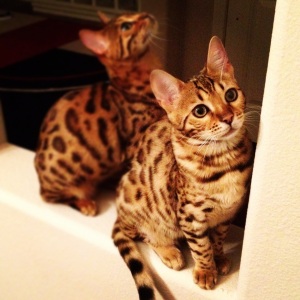

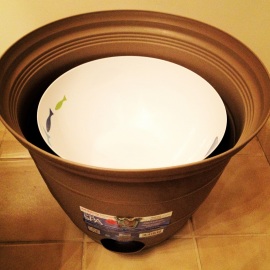
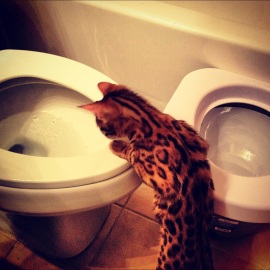


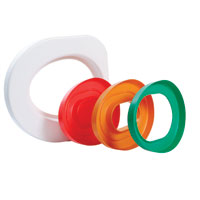
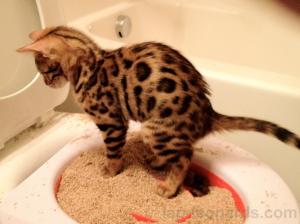
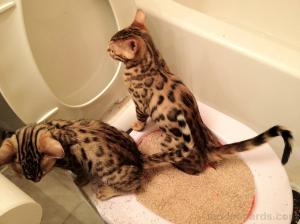
 Not long after the girls were spayed and had to endure the next 2 weeks with cones on their heads. So we regressed even further; back to the litter on the floor out of fear they would lose balance on the toilet and injure themselves. Back to square one.
Not long after the girls were spayed and had to endure the next 2 weeks with cones on their heads. So we regressed even further; back to the litter on the floor out of fear they would lose balance on the toilet and injure themselves. Back to square one.










































